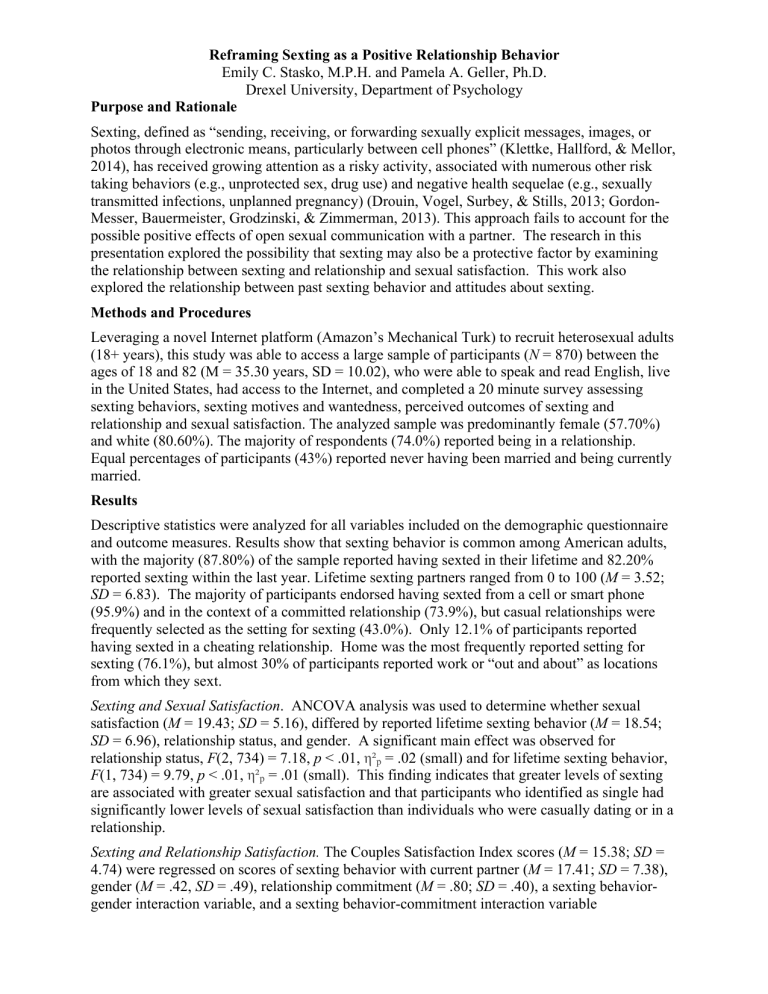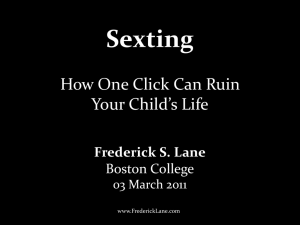Reframing Sexting as a Positive Relationship Behavior Purpose and Rationale

Reframing Sexting as a Positive Relationship Behavior
Emily C. Stasko, M.P.H. and Pamela A. Geller, Ph.D.
Drexel University, Department of Psychology
Purpose and Rationale
Sexting, defined as “sending, receiving, or forwarding sexually explicit messages, images, or photos through electronic means, particularly between cell phones” (Klettke, Hallford, & Mellor,
2014), has received growing attention as a risky activity, associated with numerous other risk taking behaviors (e.g., unprotected sex, drug use) and negative health sequelae (e.g., sexually transmitted infections, unplanned pregnancy) (Drouin, Vogel, Surbey, & Stills, 2013; Gordon-
Messer, Bauermeister, Grodzinski, & Zimmerman, 2013). This approach fails to account for the possible positive effects of open sexual communication with a partner. The research in this presentation explored the possibility that sexting may also be a protective factor by examining the relationship between sexting and relationship and sexual satisfaction. This work also explored the relationship between past sexting behavior and attitudes about sexting.
Methods and Procedures
Leveraging a novel Internet platform (Amazon’s Mechanical Turk) to recruit heterosexual adults
(18+ years), this study was able to access a large sample of participants ( N = 870) between the ages of 18 and 82 (M = 35.30 years, SD = 10.02), who were able to speak and read English, live in the United States, had access to the Internet, and completed a 20 minute survey assessing sexting behaviors, sexting motives and wantedness, perceived outcomes of sexting and relationship and sexual satisfaction. The analyzed sample was predominantly female (57.70%) and white (80.60%). The majority of respondents (74.0%) reported being in a relationship.
Equal percentages of participants (43%) reported never having been married and being currently married.
Results
Descriptive statistics were analyzed for all variables included on the demographic questionnaire and outcome measures.
Results show that sexting behavior is common among American adults, with the majority (87.80%) of the sample reported having sexted in their lifetime and 82.20% reported sexting within the last year. Lifetime sexting partners ranged from 0 to 100 ( M = 3.52;
SD = 6.83). The majority of participants endorsed having sexted from a cell or smart phone
(95.9%) and in the context of a committed relationship (73.9%), but casual relationships were frequently selected as the setting for sexting (43.0%). Only 12.1% of participants reported having sexted in a cheating relationship. Home was the most frequently reported setting for sexting (76.1%), but almost 30% of participants reported work or “out and about” as locations from which they sext.
Sexting and Sexual Satisfaction . ANCOVA analysis was used to determine whether sexual satisfaction ( M = 19.43; SD = 5.16), differed by reported lifetime sexting behavior ( M = 18.54;
SD = 6.96), relationship status, and gender. A significant main effect was observed for relationship status, F (2, 734) = 7.18, p < .01, η²
F (1, 734) = 9.79, p < .01, η² p p
= .02 (small) and for lifetime sexting behavior,
= .01 (small). This finding indicates that greater levels of sexting are associated with greater sexual satisfaction and that participants who identified as single had significantly lower levels of sexual satisfaction than individuals who were casually dating or in a relationship.
Sexting and Relationship Satisfaction. The Couples Satisfaction Index scores ( M = 15.38; SD =
4.74) were regressed on scores of sexting behavior with current partner ( M = 17.41; SD = 7.38), gender ( M = .42, SD = .49), relationship commitment ( M = .80; SD = .40), a sexting behaviorgender interaction variable, and a sexting behavior-commitment interaction variable
Reframing Sexting as a Positive Relationship Behavior simultaneously. Results revealed a significant interaction of sexting behavior and relationship commitment on relationship satisfaction, (b = -.19, SE b
= .06, p =< .01). Due to the conservative alpha-level employed in this study (.01), the interaction between gender and sexting behavior with current partner on relationship satisfaction was not significant (b = .11, SE b
= .06, p = .05).
This interaction indicates that for individuals who are not in a “very committed” relationship, sexting is positively associated with satisfaction; however, for individuals who describe their relationship as being “very committed”, sexting is unrelated to satisfaction.
Sexting and Sexting Attitudes. Three categories of sexting attitudes were included in this analysis: “Fun and Carefree,” “Perceived Risk,” and “Relational Expectations.” A multivariate multiple regression was performed to investigate the relationship between sexting behavior and sexting attitudes. A statistically significant difference in reported levels of lifetime sexting on the combined attitude variables was revealed, F (3, 696) = 50.23, p < .01, Wilks’ λ = .82, η 2 p
=
.18 (large ES). The combined dependent variables significantly differed by gender, F (3, 696) =
2 p
= .03 (small ES), and by relationship status, F (6, 1392) = 4.72, 8.01, p < .01, Wilks’ λ = .97, η p < .01, Wilks’ λ = .96, η 2 p
= .02 (small ES). When the results for the dependent variables were considered separately using a Bonferroni adjusted alpha level of .008, a statistically significant main effect for gender on Fun and Carefree, F (1, 698) = 17.06, p < .01, η 2 p
= .02 (small ES) and
Relational Expectations, F (1, 698) = 11.56, p < .01, η 2 p
= .02 (small ES) were observed, such that men reported higher levels of both categories of sexting attitudes. Additionally, a significant main effect was seen for relationship status and relational expectations, F (1, 698) = 11.24, p <
.01, η 2 p
= .03 (medium ES). This finding is driven by significantly higher relational expectations among individuals casually dating than among participants in a relationship. Examination of between-subject effects also revealed that lifetime sexting was significantly related to attitudes of
Fun and Carefree, F (1, 698) = 74.76, p < .01, η
2 p
2 p
= .10 (large ES), Perceived Risk, F (1, 698) =
36.30,
η 2 p p < .01, η = .05 (medium ES), and Relational Expectations, F (1, 698) = 91.59, p < .01,
= .12 (large ES). Individual regression models were run to explore these relationships and indicate that sexting behavior is positively associated with views of sexting as being fun and carefree and with having higher relational expectations about sexting, but that sexting is inversely related with perceived risk of sexting.
Conclusions and Future Directions
This research indicates that sexting is a prevalent behavior that adults engage in for a variety of reasons. Although the relationship between sexting and relationship satisfaction requires further attention, these findings indicate a robust relationship between sexting and sexual satisfaction.
Additionally, past experiences seem to influence individual’s attitudes about sexting, which could then impact future behavior. Given the possible implications, both positive and negative, for sexual health, it is important to continue investigating the role sexting plays in current romantic and sexual relationships. This rethinking of sexting within a sexual health framework that includes not only risk, but also pleasure has exciting potential implications for novel clinical interventions.
References
Drouin, M., Vogel, K. N., Surbey, A., & Stills, J. R. (2013). Let’s talk about sexting, baby: Computer-mediated sexual behaviors among young adults. Computers in Human Behavior, 29 (5), A25-A30.
Gordon-Messer, D., Bauermeister, J. A., Grodzinski, A., & Zimmerman, M. (2013). Sexting among young adults.
Journal of Adolescent Health, 52 (3), 301-306.
Klettke, B., Hallford, D. J., & Mellor, D. J. (2014). Sexting prevalence and correlates: A systematic literature review. Clinical psychology review, 34 (1), 44-53.





